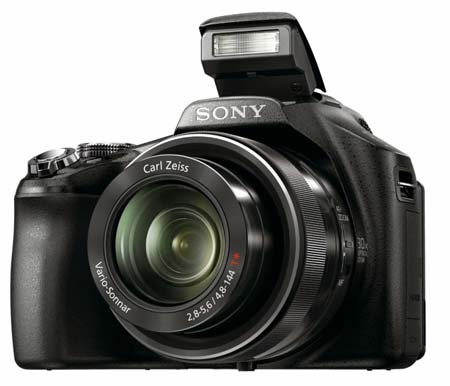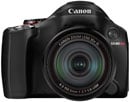Sony Cyber-shot DSC-HX100V
-
-
Written by Gordon Laing
Verdict
The Sony Cyber-shot HX100V is a 16 Megapixel super-zoom with a 30x stabilised optical zoom lens and a 3 inch flip-up LCD screen with 921 thousand pixel resolution. Sony’s first new super-zoom for nearly two years has a job on its hands to compete with the best-selling Canon PowerShot SX30 IS as well as popular models from Panasonic and Fujifilm.
On features alone though, the Cyber-shot HX100V is well-equipped for the job. Although its 30x optical zoom doesn’t have quite the reach of the SX30’s 35x zoom, it sports excellent optical stabilization coupled with good low light composite modes.
The Cyber-shot HX100V can shoot 1080p Full HD video at 50/60fps, has fast 10fps burst shooting and a wide range of clever creative modes including a new high resolution Sweep panorama mode, 3D modes, background defocus and a built-in ND filter to allow for long exposure effects in daylight shooting conditions. It also has a built-in GPS receiver.
 |
Compared to Panasonic Lumix FZ150
Panasonic’s flagship super-zoom, the Lumix FZ150, is a major rival for the Cyber-shot HX100V. Interestingly both cameras share a lot in common, including CMOS sensors, articulated 3in screens, 1080p video and fast continuous shooting. You only have to scratch the surface though to see many key differences to weigh-up.
Looking at the shared features in more detail though, the Sony features a higher resolution of 16 Megapixels to the Panasonic’s 12. In my tests the Sony captured fractionally more detail at 100 ISO, but the Panasonic enjoyed fractionally lower noise at higher sensitivities; to be honest though the difference isn’t sufficient to sway you in either direction.
In terms of their screens, both are 3in, but the Sony enjoys the advantage of a more detailed 920k panel compared to 460k on the Panasonic. It certainly looks a little sharper, but I’d trade that for the fully-articulated mount of the FZ150 compared to the Sony screen which can only tilt vertically.
As far as video and continuous shooting are concerned, they’re both very close. The FZ150 has the advantage of an external microphone input for its movies and full manual control over exposures, but if you’re happy to use the built-in mics and auto exposures, it’s essentially neck-in-neck. Similarly while the FZ150 is fractionally quicker in its continuous shooting, I wouldn’t let it influence your decision as both full their buffers in one second at their top speeds.
The biggest physical difference between them is the zoom range, with the Sony HX100V boasting a longer 30x lens, and while its widest equivalent focal length of 27mm isn’t quite as broad as the 25mm of the Panasonic, at the other end, the maximum 810mm telephoto comfortably out-reaches the 600mm on the FZ150. I additionally preferred the feel of the HX100V in my hands, although this is a personal choice.
Sony also wins on gadgetry: both cameras can generate 3D images, but the Sony additionally allows high resolution panoramas to be created with its innovative Sweep Panorama feature. The HX100V also boasts a built-in GPS to tag images with location details. Interestingly Panasonic has resisted the temptation to equip an FZ-series with GPS despite pioneering it in the TZ-series.
In the FZ150’s favour are a flash hotshoe, microphone input, greater manual control in movies, fully articulated screen and the ability to record stills in RAW. The latter is a critical advantage to the FZ150 when it comes to making the most of the image quality, and in particular retrieving blown highlight detail.
While both cameras will delight anyone shopping for a super-zoom, the Lumix FZ150 will appeal more to demanding enthusiasts, while the Cyber-shot HX100V will tick the boxes of those who love gadgets and having a longer zoom range. The FZ150 is certainly a highly compelling super-zoom camera and one you should certainly consider very carefully.
Check out my Panasonic FZ150 review for more details.
Compared to Fujifilm FinePix HS20 EXR
There are several reasons you might decide on the Fujifilm FinePix HS20 EXR as an alternative to the Sony Cyber-shot HX100V. You might prefer the manually operated barrel zoom and the wider field of view of its 24-720mm zoom lens.
The FinePix HS20 EXR can also shoot RAW, so offers more control over image processing and it features a hotshoe for mounting an external flash. And If you prefer AA batteries to a proprietary power pack, following Canon’s decision to drop AA’s in the PowerShot SX30 IS,
Fujifilm is one of a dwindling number of manufacturers to provide this option.
From a handling perspective the FinePix HS20 EXR has lots of physical controls so if you like to experiment with different settings that could be an advantage. The Cyber-shot HX100V is a better designed camera, though, it’s smaller, lighter, faster and its image quality proved superior to the FinePix HS20 EXR in both our real world resolution and high ISO noise tests.
For more details, see my Fujifilm FinePix HS20 EXR review.
Compared to Canon PowerShot SX30 IS
Compared to the Canon PowerShot SX30 IS, the Sony Cyber-shot HX100V looks to be a very compelling option. Its 16.2 Megapixel sensor provides an extra 2 Megapixels over and above the PowerShot SX30’s 14 Megapixel resolution and image quality to match and even better the lower resolution PowerShot.
It also has full 1080p50/60 HD resolution video compared with the PowerShot SX30 IS’s 720p. It beats the PowerShot SX30 IS convincingly with 10fps burst shooting, has a bigger (though not fully articulated) screen and a built-in GPS receiver.
So what’s not to like? Well, the most obvious drawback is the zoom range of the Cybershot HX100V’s lens which lacks both the super-wide angle and long telephoto extremes of the PowerShot SX30 IS. The 30x zoom on the Cyber-shot HX100V is impressive, it’s just that up against the extraordinary range of the SX30 IS’s 35x optical zoom, everything else pales by comparison.
There’s also the lack of a hotshoe and the constant irritation of the lens cap popping off every time you power up. But the only significant disadvantage is likely to be the reduced lens range, so if you can live with that the Cyber-Shot HX100V looks like a very attractive alternative to the PowerShot SX30 IS.
For more details, see my Canon PowerShot SX30 IS review.
Compared to Canon PowerShot SX40 HS
The latest Canon PowerShot SX40 HS is of course a big rival for the Cyber-shot HX100V. Like its predecessor, the biggest difference concerns the zoom range: 30x (27-810mm) on the HX100V versus 35x (24-840mm) on the Canon, so this time the Sony roughly matches the reach at the telephoto end, but doesn’t quite zoom as wide.
In terms of the screen, Sony has equipped the HX100V with a larger and much more detailed panel (3in / 920k vs 2.7in / 230k), although it only tilts vertically as oppose to the SX40 HS which twists and flips in any direction. Both cameras can shoot 1080p video, but like the FZ150 below, the HX100V does so at 50p or 60p depending on region compared to 24p on the SX40 HS; again though, some may prefer the native 24p output from the Canon. Sticking with video, the SX40 HS offers the choice of two slow motion options (320×240 at 240fps or 640×480 at 120fps) and can apply a miniature effect to 720p HD video, along with offering a fun Movie Digest feature.
Moving onto continuous shooting, both are fairly well-matched: ten frames at 10fps on the Sony compared to eight at 10.3fps on the Canon. Either way, you’re still only looking at capturing approximately one second’s worth of action.
Both cameras of course have popup flashes, but the Canon sports a hotshoe to mount external flashguns whereas the Sony does not. Both cameras also offer composite shooting modes which stack frame to reduce noise, but Sony takes the lead with multiple options including its innovative sweep panorama function (now higher resolution than ever before) and 3D image generation. The HX100V additionally sports a built-in GPS, something that’s unusually absent on the other super-zooms here.
The final big difference concerns their respective sensors: like Panasonic, Canon has reigned-in its Megapixels in an attempt to reduce noise, with the SX40 HS offering 12 Megapixels. This trend clearly hasn’t got through to Sony though which continues to push boundaries, equipping the HX100V with 16 Megapixels. As you’d expect, the Sony can capture slightly more detail at the lowest ISOs, but the Canon has the edge in noise at higher ISOs. That said as you can see in my results pages, the differences in both respects are pretty minor, especially if you’re printing images at the same size.
It’s another tough comparison to weigh-up, with the Canon boasting a slightly broader lens range, fully articulated screen, slow motion video and flash hotshoe against the Sony’s bigger, more detailed screen, Sweep and 3D Panoramas, and built-in GPS.
See my Canon PowerShot SX40 HS review for more details.
Sony Cyber-shot HX100V final verdict
It’s taken longer than usual for Sony to bring a new super-zoom to market, but the wait has been worth it. The Cyber-shot HX100V is a very capable model that’s packed full of exciting features, is nicely designed and handles beautifully. In terms of headline features it ticks just about all of the boxes with a 30x stabilised optical zoom, 3 inch flip-up screen, full HD video, and fast continuous shooting.
The list of ‘extras’ is impressively long including built in GPS location tagging, 3D modes, hi resolution panoramas, composite modes including HD and background defocus and a built-in Neutral density filter. To cap it all off, the 16.2 Megapixel Exmor-R sensor delivers top notch quality images. The only significant issue that’s likely to bother more advanced shooters is the lack of a RAW mode. If that’s a deal-breaker for you then consider the Panasonic FZ150 or the Fujifilm finePix HS20 EXR. The bottom line is Sony’s Cyber-shot HX100V promises to be one of the best super-zooms of 2011 and I have no hesitation in Highly recommending it.
Bad points | Scores (relative to 2011 super-zooms) |
 | ||
Build quality: Image quality: Handling: Specification: Value:
Overall: |
17 / 20 17 / 20 18 / 20 18 / 20 16 / 20
86% | |||








